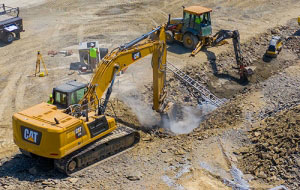Excavating Glossary: Terms to Know

Every industry is guilty of using confusing jargon that can make conversations and articles hard to understand if you don’t work in that industry on a daily basis.
With the hopes of making your life just a little easier, we put together a quick glossary of common terms you may hear in excavating.
Excavating Services/Activities
Excavator
 The term excavator can refer to two things: a type of company, and a specific piece of construction machinery.
The term excavator can refer to two things: a type of company, and a specific piece of construction machinery.
Let’s start off with the first meaning. An excavator as a company provides services related to a construction project’s site. This can include everything from demolition and site clearing to digging the foundation, laying underground utilities, and landscaping.
An excavator is also a tracked machine commonly used to tackle the above services. Its long arm can connect to a variety of attachments, making it useful for accomplishing a variety of tasks, such as digging trenches, holes, and foundations.
Excavating

There are a few different kinds of excavating you may hear reference to, including topsoil excavating, earth excavating, rock excavating, and muck excavating.
Earth Excavating
Removing the ground fill below the layer of topsoil is known as earth excavating. This is often done to make way for below-grade equipment, foundations, and grading.
Muck Excavating
Not all excavated material can immediately be used onsite. Muck excavating is when very wet soil is removed from the ground. Because of its high water content, it can’t be used for fill until the water has evaporated.
Topsoil Excavating
Buildings need compacted soil to support their structural loads. However, the top layer of soil and vegetation can’t be properly compacted. To give a site a solid foundation, the topsoil needs to first be removed. This process is known as topsoil excavating.
 Rock Excavating
Rock Excavating
In order to make way for below-grade items like pipes, foundations, and more, rock oftentimes needs to be removed along with dirt. Machines can remove these rocks, but larger ones may need to be broken into pieces first, either with excavating equipment or blasting. These larger rocks can be broken down into smaller pieces and used for other building applications. For more on rock removal, read our blog.
Cut and Fill
Whether for grading purposes or removing earth to make room for underground utilities, foundations, etc., cut refers to the process of removing material from the ground. The displaced materials, which can consist of topsoil, earth, rock, etc., are called fill. Fill can be used to level the ground, elevate the ground, and more. Fill that is rocky can also be broken up into smaller pieces to be used as the base of roads and more.
Demolition
Excavators know how to handle big equipment, which is what’s needed for knocking down buildings and clearing away the debris. They also know how to do so safely, to ensure the structure comes down with minimal impact on the health of all those around. For more on demolition services, click here.
Dredging
Over time, particulates and erosion make their way to bodies of water through rain and wind erosion where they build up. Dredging refers to the process of removing these sediments from the beds of rivers, lakes, and other bodies of water. It helps curb flood risk by removing particulate pollution that displaces the water.
Erosion Control

For more on the different methods of erosion control, check out our blog.
Grading
Grading is when you manipulate the ground level. Excavating companies will use equipment to spread topsoil and other fill materials in a particular spot of land to create a smooth, even surface. They’ll fill in holes and bumps, so the base of the project is nice and level.
Preconstruction
Preconstruction is the formal planning stage of a construction project. This can include things like budgeting, managing building codes and regulatory requirements, value engineering, and more. It’s an important step in the construction process, and it’s often helpful to have an excavator weigh in. As one of the first contractors on a jobsite, they’ll contribute to the overall plan in a meaningful way.
 Road & Infrastructure Construction
Road & Infrastructure Construction
From busy intersections to commercial parking lots, many excavators are also skilled in roadways and infrastructure construction. Their expertise is needed to create a smooth and level base upon which roadways can be built. For more on road and infrastructure construction, click here.
Soil Remediation
Sometimes, the soil on a jobsite is contaminated with harmful or undesirable materials. Soil remediation is the process of removing or neutralizing that soil, leaving a safe and clean site to build on.
Trenching
A trench is a hole that is longer than it is deep. These are dug from the ground to house things like utility pipes and cables, sewers, and foundations.
 Underground Utilities
Underground Utilities
Underground utilities include the necessary hookups for sewers, storm drainage, water mains, forced water mains, water services, and retention systems. Whether it’s laying new lines or repairing old or damaged ones, doing so takes skill and precision.
This can also include the creation of pedestrian and recreation paths, bridges, complex infrastructure stations, and more.
Prime Contractor
Some excavators may work under a prime contract, or as a prime contractor. This means they’re working directly for the project owner with no other project management team acting as the in-between.
Subcontractor
Excavators can also work as a subcontractor. In this scenario, they’re working for a project management team, be that a general contractor, construction manager, or design-builder. The excavator will have a contract with this firm, as opposed to having a contract directly with the owner, as would be the case in a prime contractor scenario.
Common Equipment
 Articulated Trucks
Articulated Trucks
These large, rugged trucks haul material and waste across rough terrain. They can climb steep inclines, and handle slippery mud, allowing them to go where other haulers can’t.
Backhoes
Backhoes are like excavator’s little brother. They differ from excavators in the way they’re designed and the tasks they can accomplish. Backhoes are usually smaller and roll on rubber tires. But with a boom that has a 200-degree rotation and a front loader bucket they are very versatile on the job site.
Dozers
Dozers push soil, sand, and rubble and loosen densely compacted materials. Equipped with modern technology, they can use GPS to clear and grade land very accurately.
 Dump Trucks
Dump Trucks
Dump trucks are articulated trucks’ smaller and nimbler brother. That said, dump trucks are far from small. But whether single-axle or triaxle, they can easily travel on paved roads, making them the better option to haul material off the jobsite.
Graders
Graders are used for grading, or smoothing surfaces before paving. They help ensure the ground is smooth and level.
Loaders
Skid loaders, track loaders, and wheel loaders are versatile machines that can accomplish a wide variety of excavating tasks. They can clear the ground and transport debris and other loads around the jobsite.
 Rollers
Rollers
There are several different types of rollers, ranging in size and composition. Vibratory rollers are typically on the larger end of the spectrum and are used to compact soil like silt and clay. Walk-behind rollers are smaller and either require an operator to walk behind them and control them or manipulate their movements by remote. These smaller rollers still compact the ground but are much nimbler.
Scrapers
Scrapers are a combination of a loader and a truck. As they travel over the work area their horizontal cutting edge slices the dirt and collects it in their hopper to be carried across the site and placed where needed.
Have More Questions?
Did we miss a term you are looking for? Do you have a question related to excavating? Send us a message and let us know!
Want to keep this glossary around for reference? Click here to download a printable version!
Posted July 14, 2021

 Rock Excavating
Rock Excavating
 Road & Infrastructure Construction
Road & Infrastructure Construction Underground Utilities
Underground Utilities Articulated Trucks
Articulated Trucks Dump Trucks
Dump Trucks Rollers
Rollers